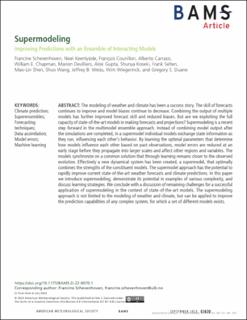| dc.contributor.author | Schevenhoven, Francine Janneke | |
| dc.contributor.author | Keenlyside, Noel Sebastian | |
| dc.contributor.author | Counillon, Francois Stephane | |
| dc.contributor.author | Gupta, Alok Kumar | |
| dc.contributor.author | Koseki, Shunya | |
| dc.contributor.author | Shen, Mao-Lin | |
| dc.date.accessioned | 2024-03-19T13:45:26Z | |
| dc.date.available | 2024-03-19T13:45:26Z | |
| dc.date.created | 2023-11-20T15:28:42Z | |
| dc.date.issued | 2023 | |
| dc.identifier.issn | 0003-0007 | |
| dc.identifier.uri | https://hdl.handle.net/11250/3123161 | |
| dc.description.abstract | The modeling of weather and climate has been a success story. The skill of forecasts continues to improve and model biases continue to decrease. Combining the output of multiple models has further improved forecast skill and reduced biases. But are we exploiting the full capacity of state-of-the-art models in making forecasts and projections? Supermodeling is a recent step forward in the multimodel ensemble approach. Instead of combining model output after the simulations are completed, in a supermodel individual models exchange state information as they run, influencing each other’s behavior. By learning the optimal parameters that determine how models influence each other based on past observations, model errors are reduced at an early stage before they propagate into larger scales and affect other regions and variables. The models synchronize on a common solution that through learning remains closer to the observed evolution. Effectively a new dynamical system has been created, a supermodel, that optimally combines the strengths of the constituent models. The supermodel approach has the potential to rapidly improve current state-of-the-art weather forecasts and climate predictions. In this paper we introduce supermodeling, demonstrate its potential in examples of various complexity, and discuss learning strategies. We conclude with a discussion of remaining challenges for a successful application of supermodeling in the context of state-of-the-art models. The supermodeling approach is not limited to the modeling of weather and climate, but can be applied to improve the prediction capabilities of any complex system, for which a set of different models exists. | en_US |
| dc.language.iso | eng | en_US |
| dc.publisher | AMS | en_US |
| dc.rights | Navngivelse 4.0 Internasjonal | * |
| dc.rights.uri | http://creativecommons.org/licenses/by/4.0/deed.no | * |
| dc.title | Supermodeling Improving Predictions with an Ensemble of Interacting Models | en_US |
| dc.type | Journal article | en_US |
| dc.type | Peer reviewed | en_US |
| dc.description.version | publishedVersion | en_US |
| dc.rights.holder | Copyright 2023 American Meteorological Society | en_US |
| cristin.ispublished | true | |
| cristin.fulltext | original | |
| cristin.qualitycode | 2 | |
| dc.identifier.doi | 10.1175/BAMS-D-22-0070.1 | |
| dc.identifier.cristin | 2199018 | |
| dc.source.journal | Bulletin of The American Meteorological Society - (BAMS) | en_US |
| dc.source.pagenumber | E1670–E1686 | en_US |
| dc.relation.project | Sigma2: nn9039K | en_US |
| dc.relation.project | Sigma2: ns9039k | en_US |
| dc.relation.project | Sigma2: nn9385K | en_US |
| dc.relation.project | Sigma2: ns9207K | en_US |
| dc.relation.project | EU/101101037 | en_US |
| dc.relation.project | Trond Mohn stiftelse: BFS2018TMT01 | en_US |
| dc.relation.project | Norges forskningsråd: 310098 | en_US |
| dc.identifier.citation | Bulletin of The American Meteorological Society - (BAMS). 2023, 104 (9), E1670–E1686. | en_US |
| dc.source.volume | 104 | en_US |
| dc.source.issue | 9 | en_US |

